Today we are witnessing a global transformation of our way of working. We carry out projects, interact with clients, and work on new products together with colleagues. Increasingly, you can hear about the importance of teamwork and blurring the lines between superiors and subordinates. This also applies when we work together to improve productivity and achieve common goals. In this article, we will talk about the ideal integration of applications created for collaborative work: Microsoft Teams and Outlook.
Microsoft Teams as a tool for collaborative work
Microsoft Teams is a tool for productive and collaborative work in an organization. Companies use teams to create a unified environment based on data from Office 365 users. Usually, as soon as a new employee joins a team, they receive a service domain in Office 365 and automatically become a part of the working community. In a few steps, they will be able to join various teams, share useful information via channel posts, exchange important files, and participate in online meetings.
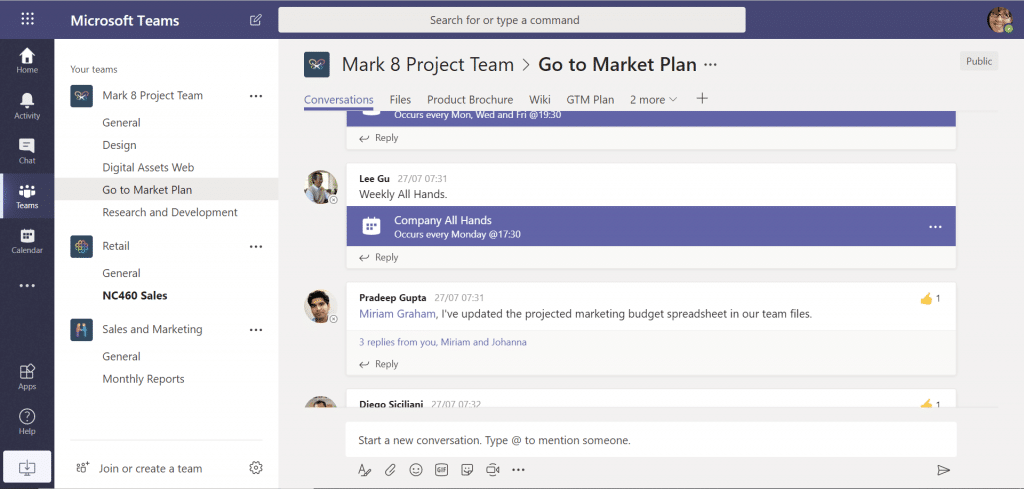
All this becomes possible thanks to Teams’ user-friendly interface, which undoubtedly meets all the requirements for teamwork. So, in their workspace, a new team member gets an environment along with a file sharing service, quick communication with colleagues, access to corporate data, and important projects. Have we forgotten something else? Yes, I see – something that no working day can go without. This is a work email.
Email will never die
Indeed, me and my colleagues start their working day by checking their e-mails. Appeared in the 60s, this tool has become a necessity in our daily tasks. E-mail is key and sometimes the only way to communicate with external agents, customers, and suppliers. In addition, we can exchange confidential files with internal departments of the company, regardless of the geolocation of our office. Receiving important messages, reminders, storing correspondence data, receiving mailings from topical magazines, or, conversely, notifying customers about special offers is only a small part of our mailbox.
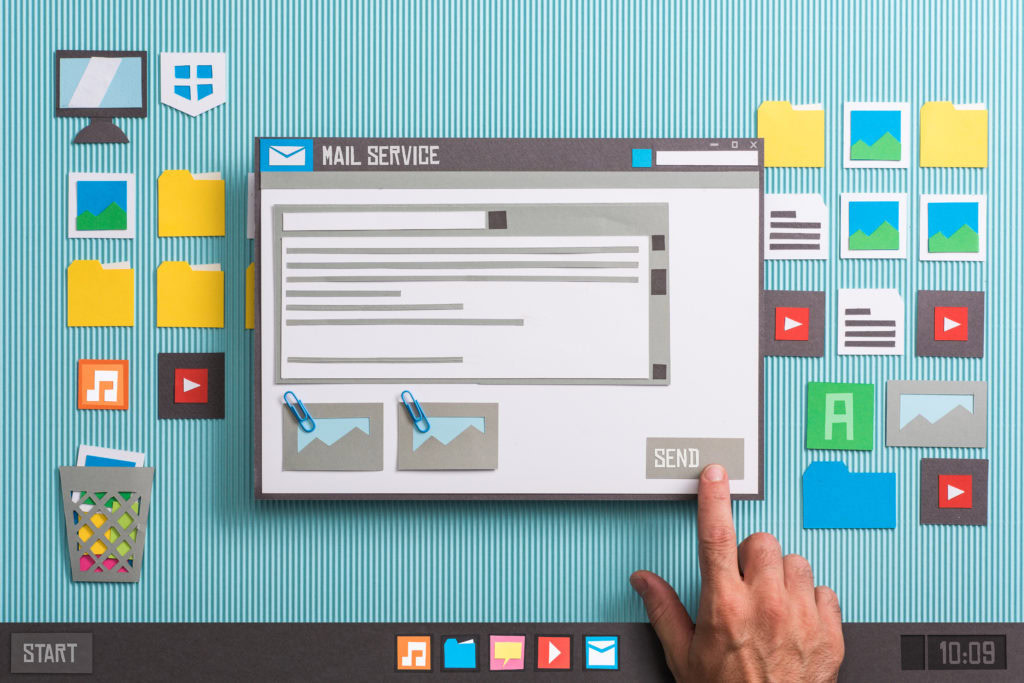
Today there is a huge number of services with which you and your colleagues can perform current tasks. Even though they serve the same main purpose – instantaneous exchange of information through the global network, they still differ from each other. Various interfaces, additional functions, security, and editing tools. We suggest considering an ideal service for corporate use – Outlook – which today has more than 400 million accounts.
Outlook innovations
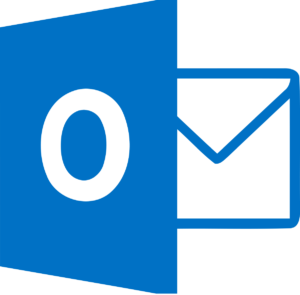
Outlook is a great tool incorporated into the Office 365 suite. It is used to receive and reply to all your emails, organize and save contacts, and manage your appointments, meetings, and daily tasks. For this reason, this software is widely used in either a personal or a business environment.
Outlook has so many features and serves to simplify your work experience. Let’s look in detail at the main components and new tricks.
Email accounts
In order to start working with Outlook, you need to add your Office 365 account. This is your corporate mailbox, which allows you to communicate with colleagues, clients, and external organizations.
If necessary, you can add additional accounts. For example, sometimes organizations create a shared email address for fast communication between colleagues and the service desk. In addition, the team can work on a large project with one email. This is so convenient – all your accounts are easily changed and managed in one place. An additional option is to add a personal account if your corporate rules allow it. This is a great opportunity to optimize corporate collaboration on your schedule, which we will talk about later.
Outlook interface
After adding an account, you will get to the Outlook interface. This simple and intuitive virtual environment allows you to stay focused and organized. Space is conditionally divided into three parts.
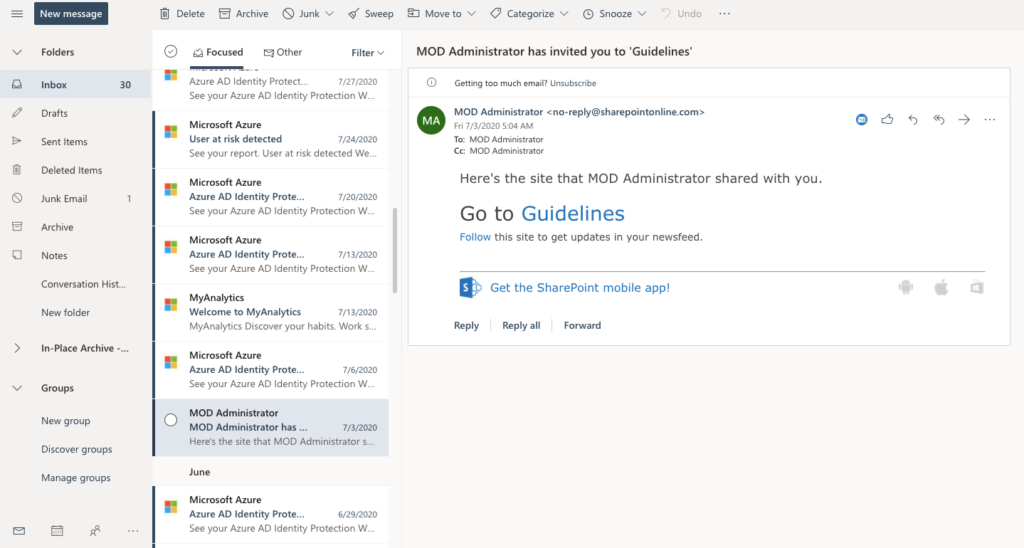
On the left, you will see Folder Pane. It shows all your connected email accounts with their folders inside that you can manage and customize as you like. At the bottom, you can see the calendar icons as well as all your contacts. You can easily manage and group them according to your needs.
In the center, you have the Mailbox. It shows all the emails contained inside the selected folder, complete with the sender’s name, subject, date, and description.
On the right you have the Reading Pane, showing the full content of the email selected from the Mailbox.
Mailbox in Outlook
Tha Mailbox list contains all the emails inside the folder you have selected from the Folder Pane. All the items are ordered chronologically, starting from the most recent ones by default. In case you start having lots of items, you can either use the Categories to look at your email easily. This will also allow you to recognize the email from the others through its colored rectangle.
Also, you can easily find a needed email by using the Search bar – just provide keywords, for example, subject, category, or the sender’s name.
One more useful advantage here is the Focused Inbox. This helps you stay focused on the emails that matter most to you. Thus, your most important emails are on the Focused tab while the rest remain easily accessible – but out of the way – on the Other tab. Anyway, you will be informed about email flowing to Other. And of course, you can easily manage this process. For example, if some email goes to Another tab that you’d rather see in Focused Inbox, you can easily move it.
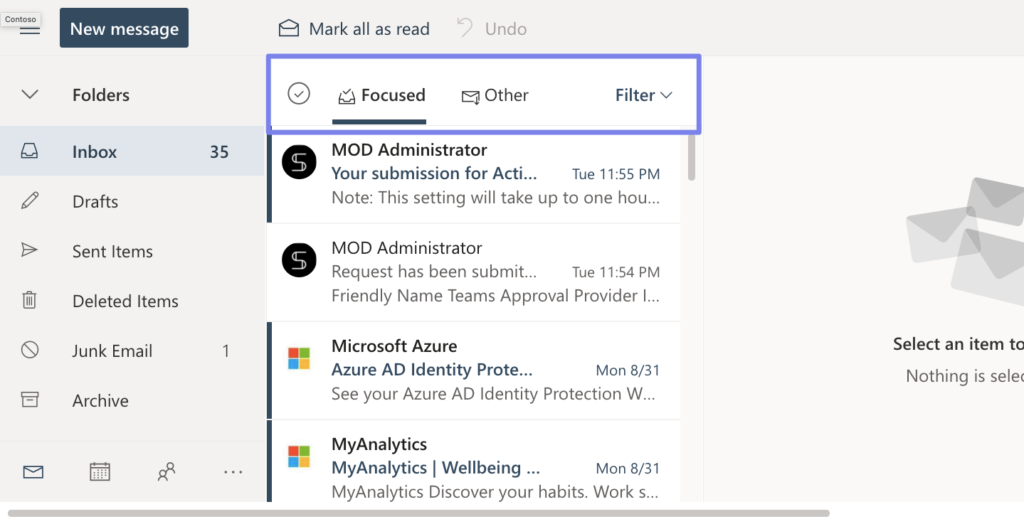
Writing an email
To send an email you should choose a recipient from the list of your contacts or write a new email address. You can easily send the email to multiple recipients without showing these in the list of recipients. Outlook has a very user-friendly interface to edit your message. You can adjust the text properties, such as font family, size, color and distribution. Now you can bring visual interest to your documents and presentations by inserting Scalable Vector Graphics (SVG). If needed, attach files from your OneDrive or from your computer by dragging and dropping these on your email directly.
Outlook Calendar
Calendar in Outlook shows all your daily events with time and location fixed in order to stay organized. Outlook manages your events in two mail items. The appointments are personal duties you fix on your own to remember and organize these easier. The meetings are appointments shared with other people.
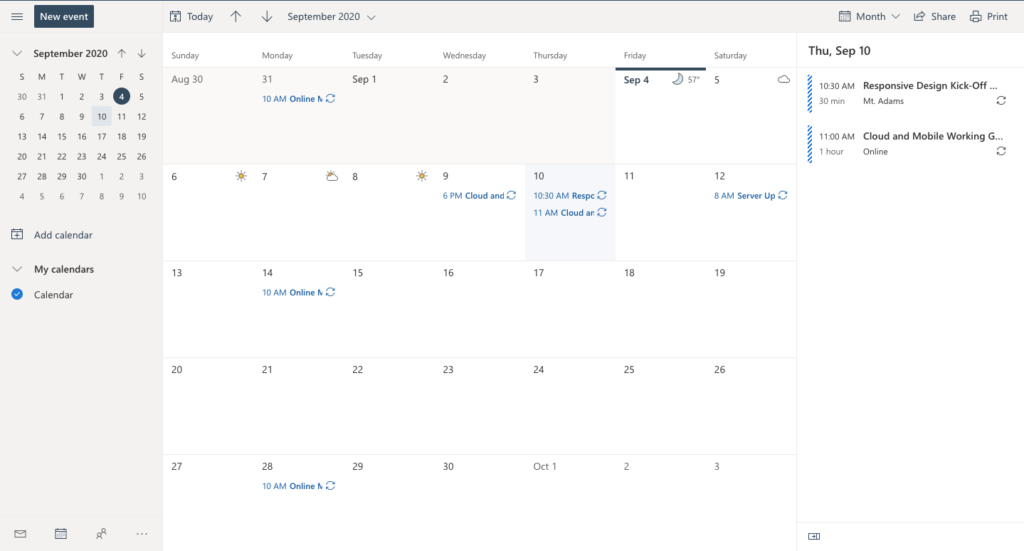
During the creation of a new appointment, you can add the subject, time, location, and any notes. In addition, you can upload an attachment. When you need to schedule a meeting across time zones, you are able to add multiple time zones to your calendar. Thus, you will easily see everyone’s availability and pick a time that works for all. Also, you can use Reminder to enable pop-up notifications before the event starts, and Recurrence to make the event repetitive. This appears on the calendar with its hour, subject name, and location.
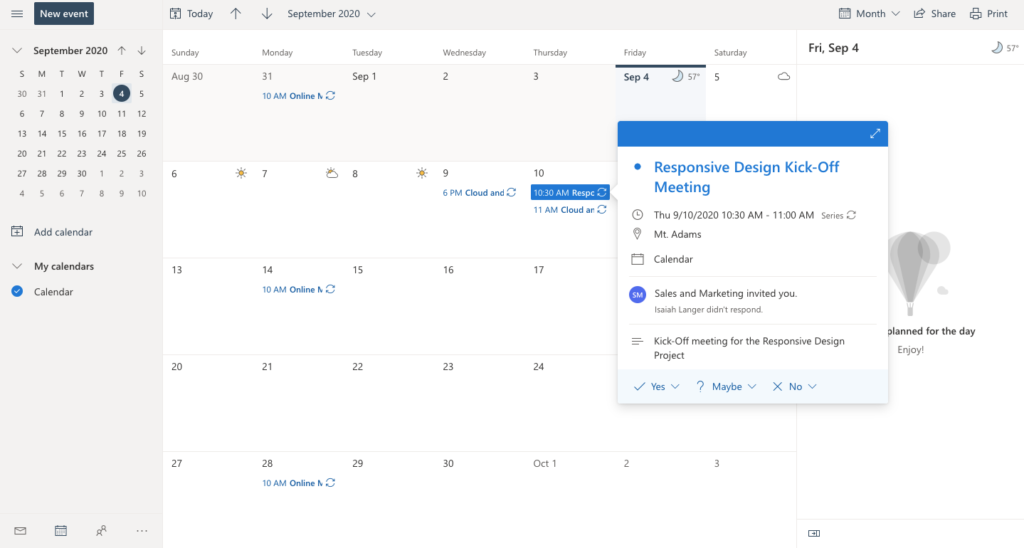
Moreover, if you click on invite Attendees under the Event tab, you transform your appointment into the Meeting. You can invite people like Required, Optional, or Resources. Whereas, when receiving Outlook invitations on meetings, these come as the new emails, with a meeting icon on the right side. On top of the invitation, you can Accept, Decline, or mark your presence undefined with Tentative. In this case, you can use Propose a new time to reply by proposing a new time for a meeting. In the latest update, you can see people’s responses to a meeting request, even if you aren’t the meeting organizer. It’s so useful to know who you’ll be meeting with.
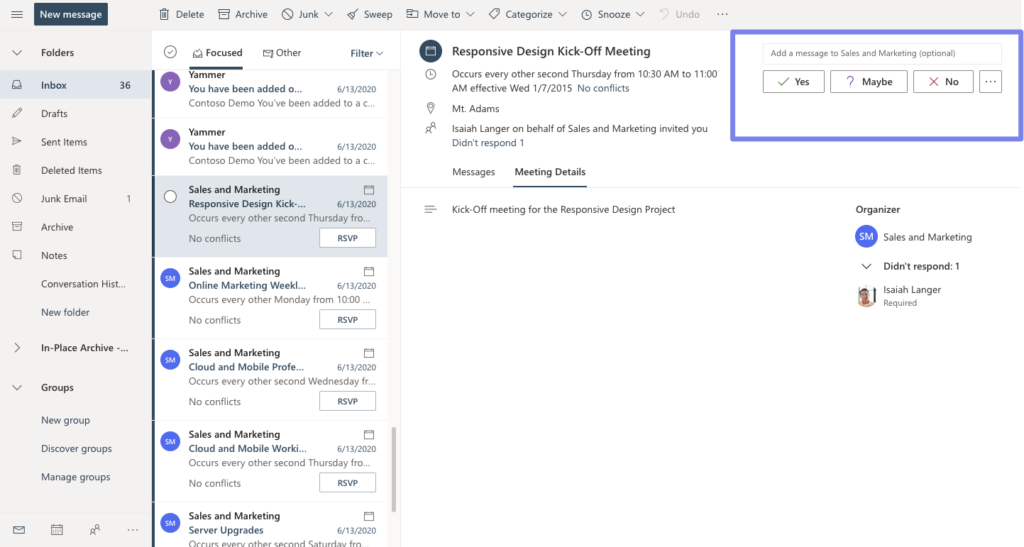
Do you remember that we told about some tips related to your personal account? It’s time to talk about this. Your colleagues can see your personal events on the calendar. Thus, you can avoid conflicts and simplify your schedule management.
Safety
Every day you share highly secured information by email. It could be financial reports, customer’s data, or confidential product information. Thus, you must be sure that there is no risk of information leakage after a message leaves the premises of your organization. With Outlook your environment is safe because this software protects your data from all the types of information leakage.
Thus, Outlook provides you with the protection delivered by the same tools Microsoft uses for business customers. With a Premium version, you can even deactivate automatically unsafe links containing phishing scams, viruses, or malware. As well as detect ransomware and recover your important files in an OneDrive. In addition, you can manage Outlook protection rules thanks for Information Rights Management
And of course, Outlook is transparent about data collection and use so you can make informed decisions. They don’t use your email, calendar, or other personal content to targets ads.
MS Teams and Outlook: how to use them together
As you may know, Microsoft Teams is useful not only for its interface and many features but also for perfect integration with other applications. Indeed, you can personalize your Microsoft Teams according to your needs. Any of the apps in the Microsoft Store, as well as the tools that you use in your internal corporation can be integrated with Microsoft Teams and increase your productivity. Have a look at some examples of use cases on how you can integrate Microsoft Teams and Outlook.
→Download: Catalog of Microsoft Teams Use Cases
Share from Teams to Outlook
Let’s imagine that you and your team are working on a new project. You work as a project manager and lead several projects. In multitasking mode, you have no time to view all the conversations and discussions of your team. At the same time, you want to be notified of current statuses, important news, and updates. You also want to stay in touch with your team in case of controversy. So how do you stay informed without diving deep into all the dialogues?
Integration of Microsoft Teams and Outlook comes to the rescue. Your team members can send you important conversations directly from and without leaving Microsoft Teams. You will receive an email where you can view the posted conversations. What is important, you will receive an active dialogue in which you can see all the replies that appeared there after the email was sent. In addition, you will be able to view the attached files.
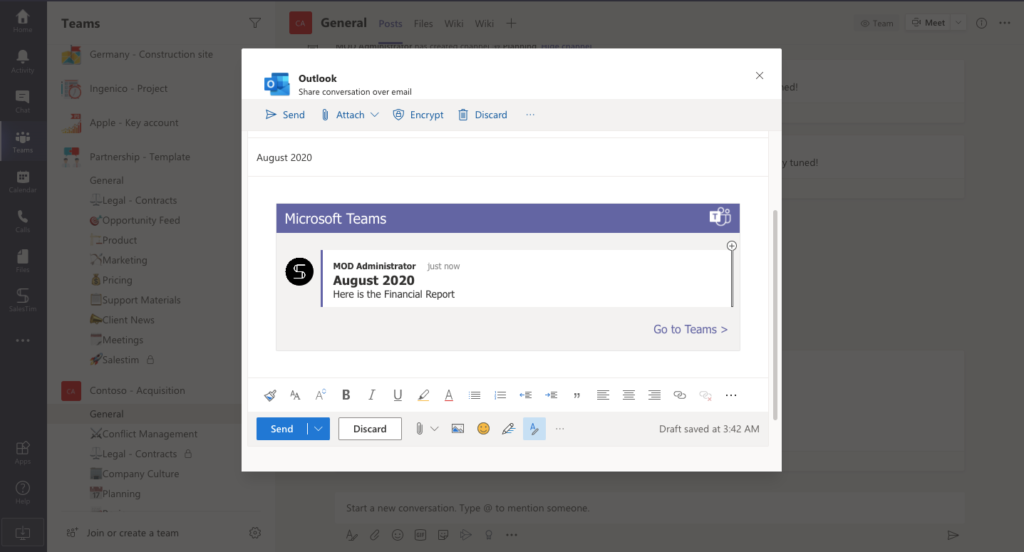
So, very simply, you will stay informed about the latest updates and important stages of the project. At the same time, your team will be able to get help from you in case of disputable situations, because you can easily answer the discussion directly from Outlook.
Share from Outlook to Microsoft Teams
Here’s another example of how the integration of Outlook and Microsoft Teams can be useful. Is it possible to do it vice versa and share a message from Outlook to teams? Of course, and it’s very easy!
Let’s say you work in customer support. You receive hundreds of emails from customers asking you to solve their problems. Usually, you handle the task on your own. But sometimes you are faced with particularly important or complex cases that require the involvement of additional specialists from your company. In one click, you can share an email with the team or channel you need. So, in a new discussion, the participants will be able to cooperate and solve the problem together
Online Meetings in Teams right from Outlook
What about online meetings? Microsoft Teams and Outlook help you cope with daily tasks and meetings. So, you can view and manage your calendar without leaving your team. As well as getting notifications and quickly joining meetings.
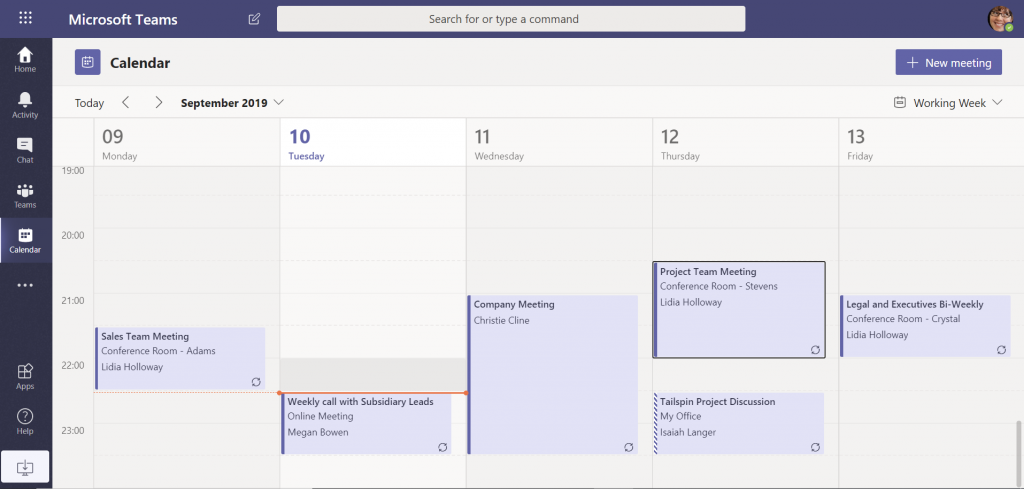
At the same time, by scheduling a new online meeting in Outlook, you have the opportunity to create a meeting right in Microsoft Teams. The invited users will receive an email invitation with all the details and a link to join the meeting (even if they are not members of your Microsoft Teams environment)
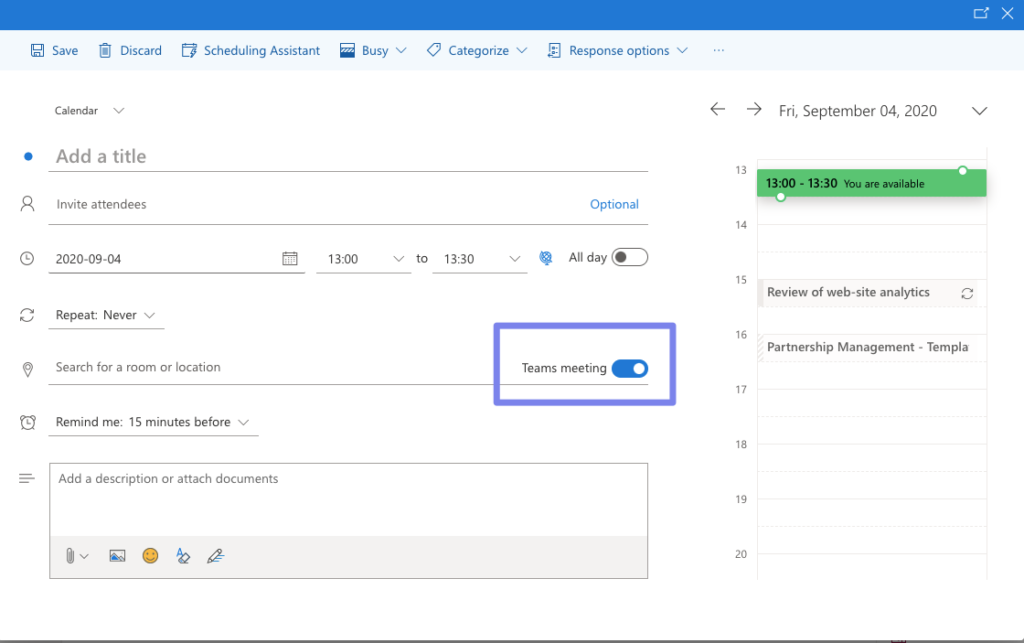
Contact’s integration from Outlook to Teams
Finally, a handy feature for those who constantly interact with their contacts in Outlook. In Outlook, you can manage your contact list and group them according to your needs. Rest assured that when integrated with Microsoft Teams, your contacts will be duplicated in your Teams interface. View phone numbers and other information about contacts, interact with colleagues or clients without leaving Microsoft Teams.
Teams and Outlook integration through Power Automate
Do you know something about Power Automate? It’s software that allows you to simplify your processes by streamlining repetitive tasks. With ready to use templates, you can build the workflows that simplify your activity from notifications settings to the data collection process.
You can also save your time by building the workflows into everything from individual tasks to large-scale systems with seamless integration using hundreds of pre-built connectors. Just choose the apps you often use and optimize your environment so you can shift your energy from repetitive tasks and focus on what matters most. Let’s look at some scenarios that you can perform with Teams and Outlook thanks to Power Automate technology.
Notification settings
Sometimes, people who work a lot in one software forget to check out other apps. Would you like to stay informed about all the new messages? So, you can try the pre-built workflow and get the post message to Microsoft Teams when an email arrives in Outlook. When an email arrives in Office 365 Outlook, check the email body content with the specified condition. If the condition matched, then post a message to Microsoft Teams with email body content. Try it
Other way round, you can automatically get the email in Outlook when a new message is added to Microsoft Teams. Get it
Updates with daily events
To keep your team organized, you can inform them about all the tasks and events from that day. Explore the workflow to update Microsoft Teams daily with Outlook. Daily provide a brief update to a team in Microsoft Teams of Office 365 Outlook events from that day. Learn more
Daily reporting
To stay efficient or track your worker’s activity, you can build the workflow with the daily reports. Automatically get a daily report on Outlook email of spent time on calls in Teams and emails. You will need to add a spreadsheet to Excel once with the following columns: name, email, count, and type. Read more
How do Collaboration Templates connect Teams and Outlook?
Let us conclude by sharing some other ways you can improve Teams collaboration at the scale of your organization. With nBold you can let your end-users create teams from pre-built Templates. Copied Channels, Tabs, Files, Settings, and Members are included. In addition, you are able to manage Collaboration Governance with Naming Convention, Permanent Memberships, Security Policies, Targeting Audience, and Approval Workflows.
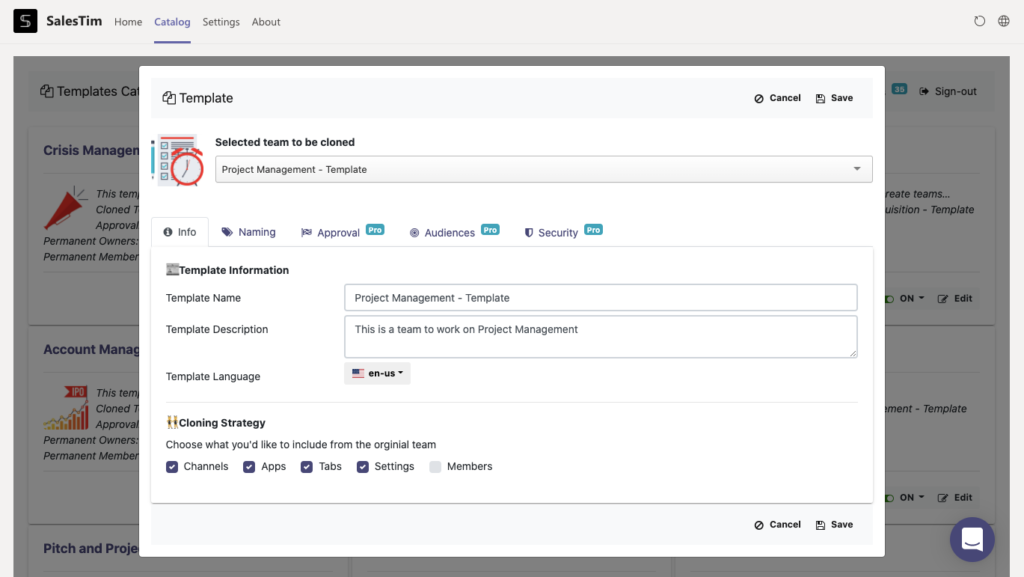
Let’s talk about the approval workflows technology in detail. With Approval Workflows, you can decide, who will be able to use your Template. Thus, you are able to control newly created teams. It is possible thanks to the nBold integration with the Outlook Actionable Message. This enables you to take quick actions right from your inbox within Outlook. Outlook Actionable messages are emails that embed Adaptive Cards in a very secure way, by enforcing both end-user authentication and phishing prevention. Learn how to set up the Outlook Actionable Message in our documentation and enable it in nBold settings at the tenant level.
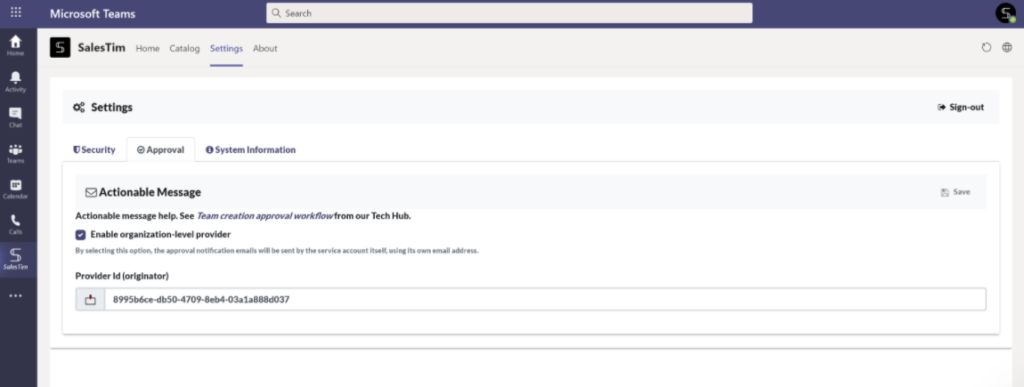
What’s next?
During the new template creation, you can enable approval workflows and choose the approvers by entering their names. Now, each time when someone uses this particular template, the approvers will get the message right in their Outlook.
They can accept the request and, in this case, an end-user will get the fully provisioned team from the template with copied Channels, Tabs, Files, Settings, and members in a few seconds.
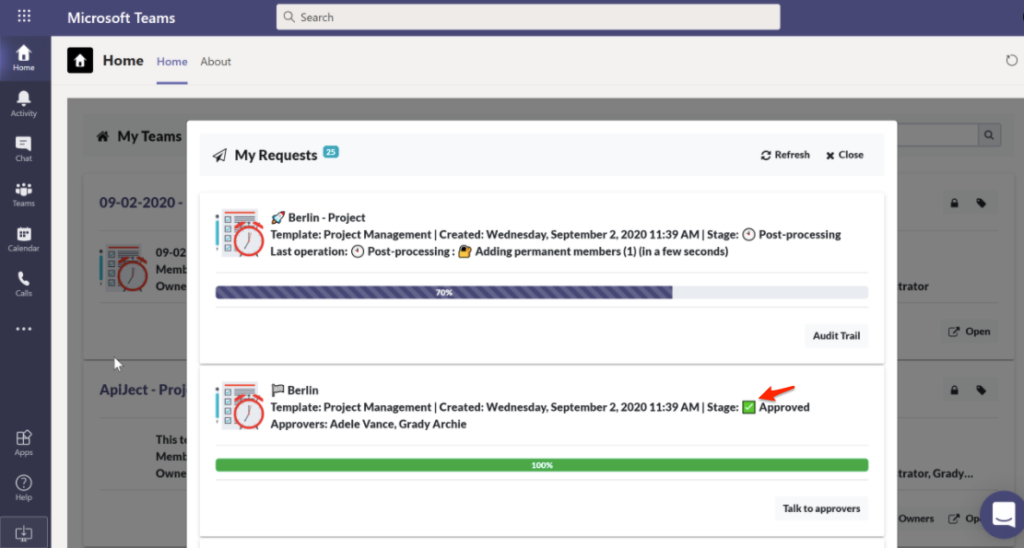
Otherwise, the approver can reject the request and add the comment explaining the reasons, if needed. In this case, the requester will see that the request has been rejected with the comment.
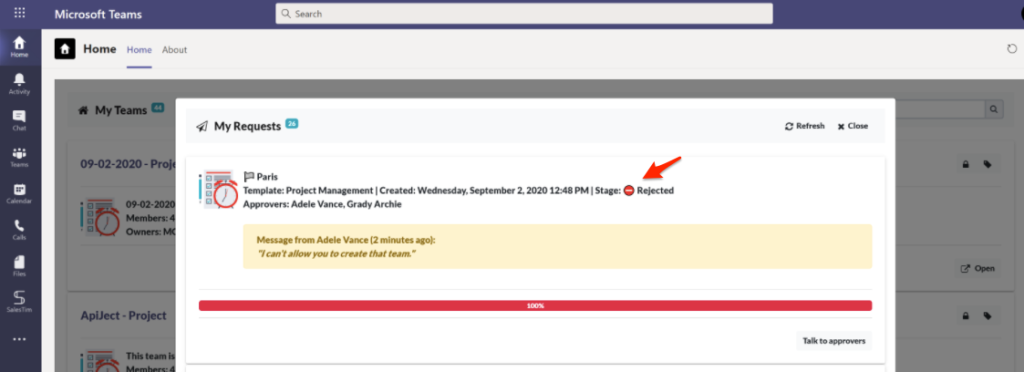
Learn more about Collaboration Governance

